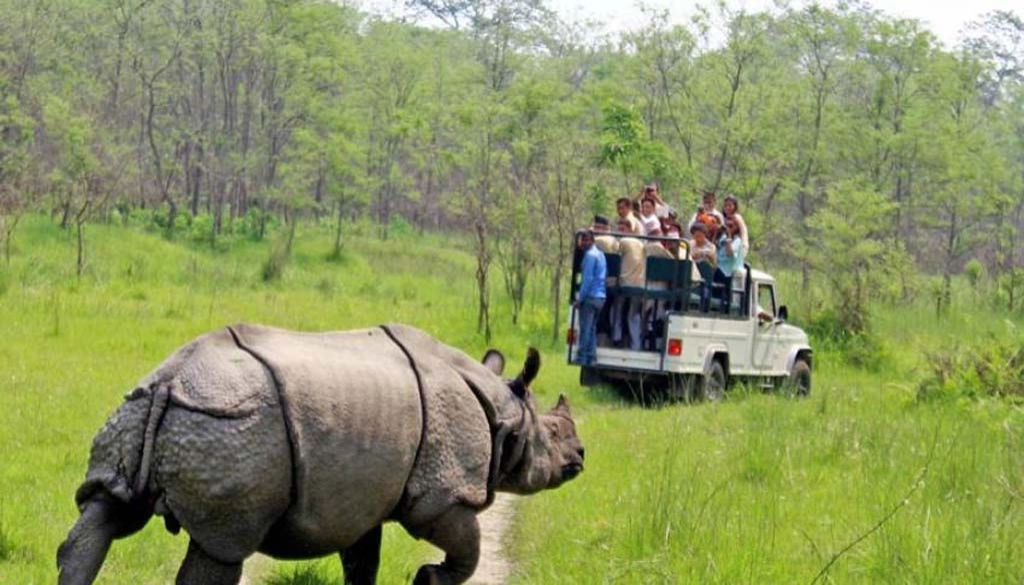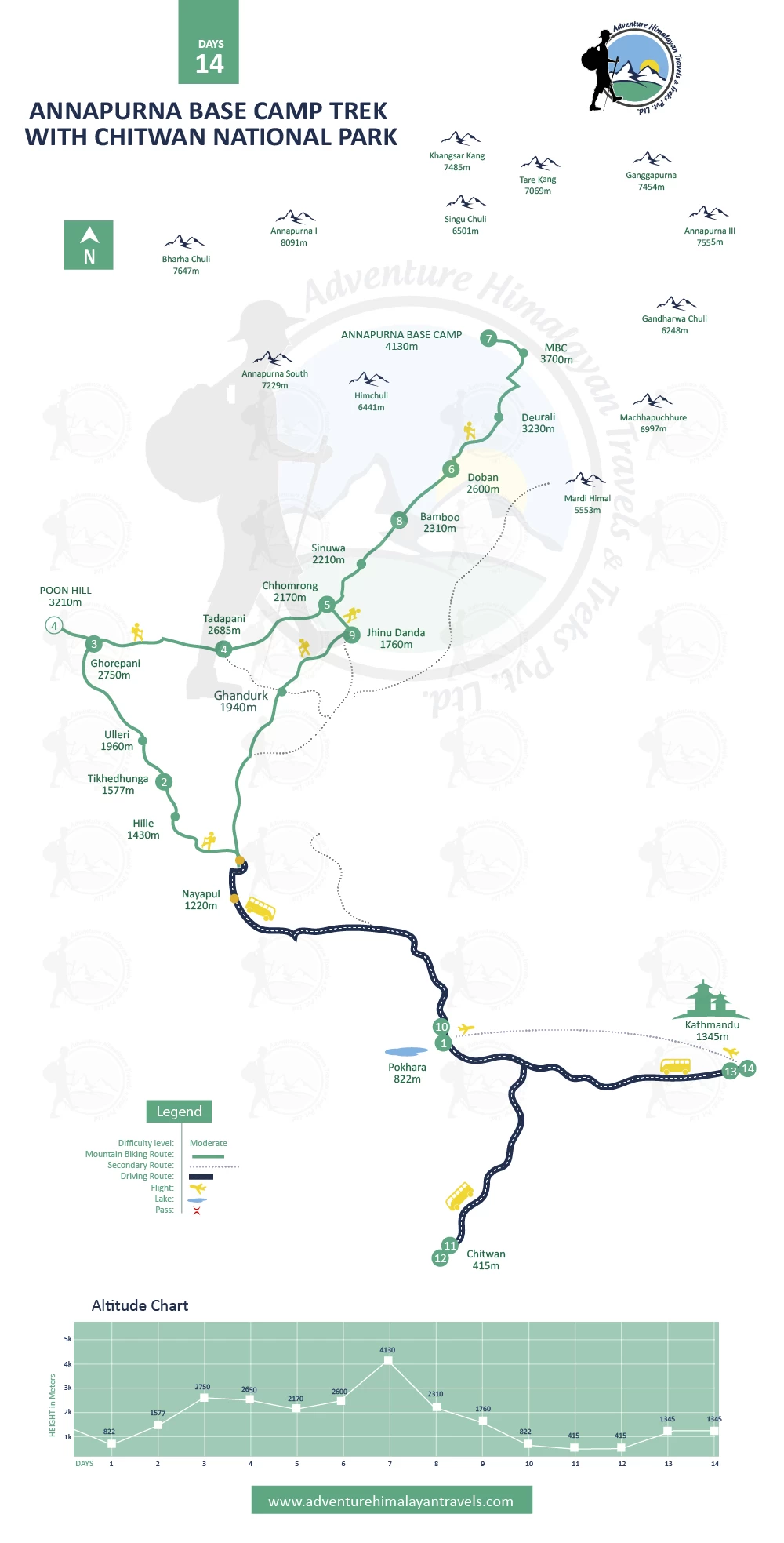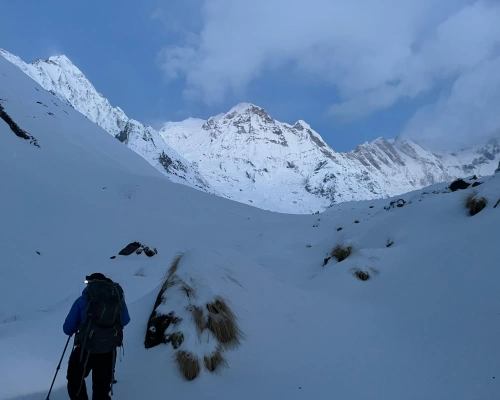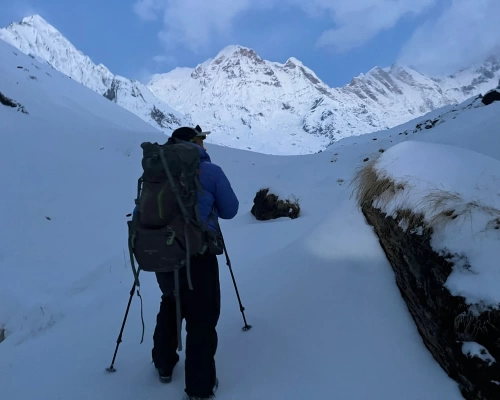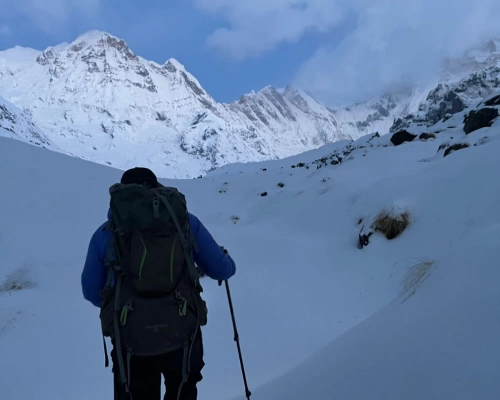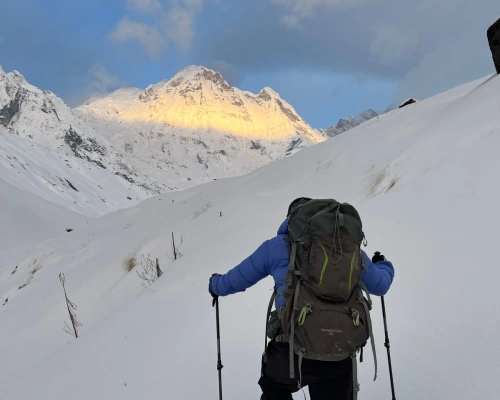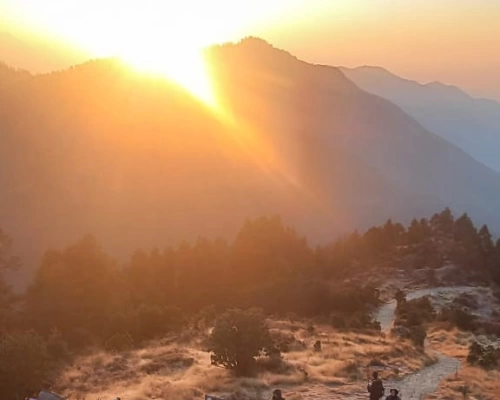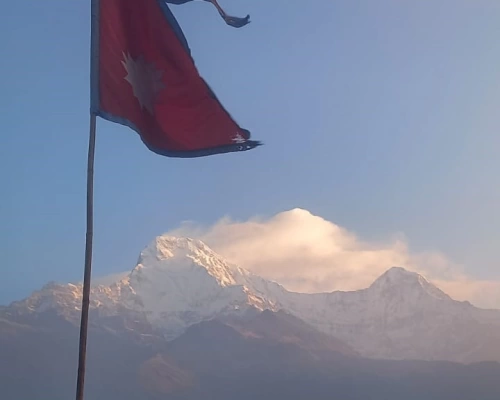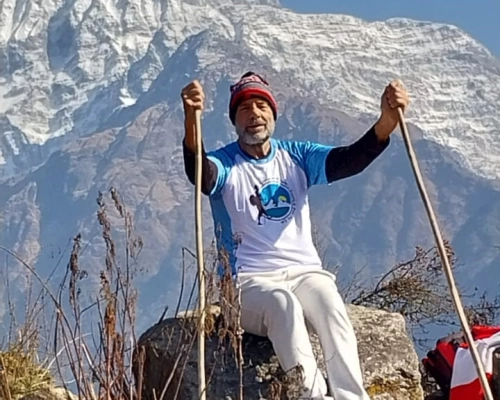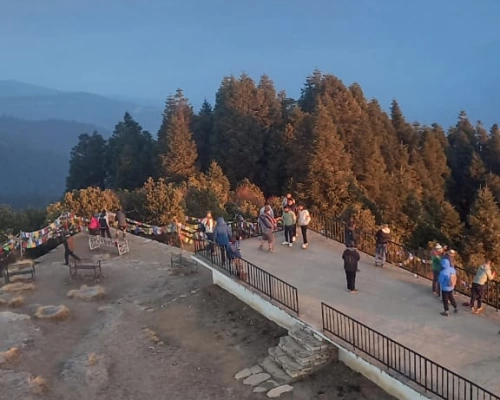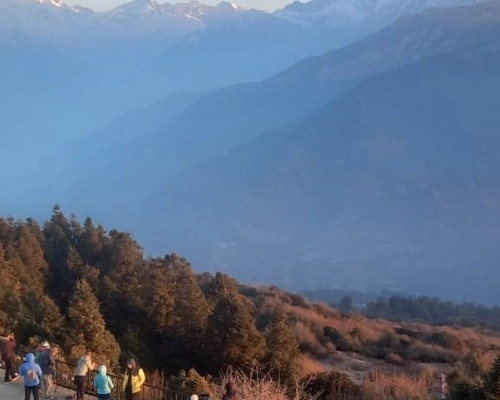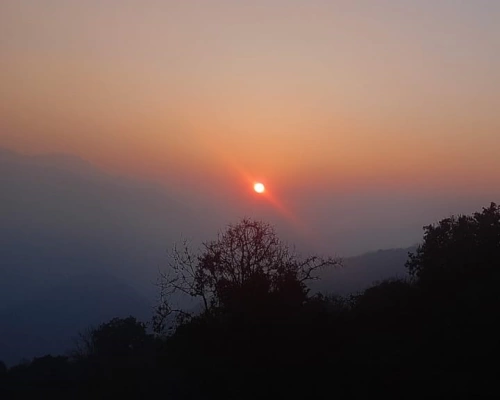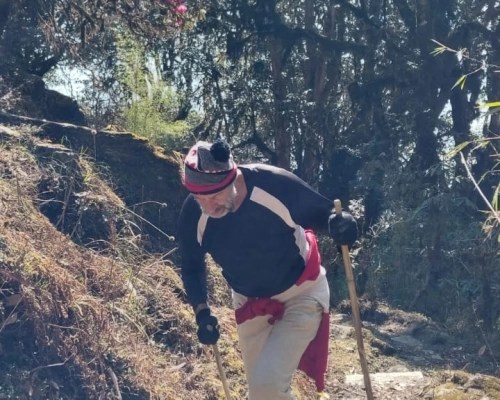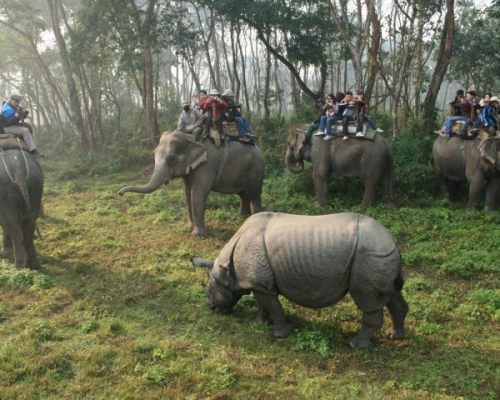Annapurna Base Camp Trek with a side trip to Chitwan National Park in 14 days is a balanced expedition from the north-central of the Himalayas to the south-central region of the Terai, posing the opportunity of a lifetime that provides you with the greatest exposure to Nepal’s diverse landscape and culture.
The first section of the trek lets you explore the infamous base camp of the world’s tenth highest mountain, Mt. Annapurna I (8,091 m), and its abundant rich tapestry, including the ethnic lifestyles, authentic valleys, and true sense of trekking in the Himalayas, while staying in the tea houses and local lodges opened by locals at the foot of Mt. Annapurna.
In the second half of the Annapurna Base Camp with Chitwan National Park, you will find yourself in the raw wilderness of the national park filled with the vibrant amalgamation of a wide range of flora and fauna preserved which once used to be the favorite hunting spot of the royals in old Nepal which is no longer legal in the country.
Yet, the adventure is real when you ride the elephant or jeep for a jungle safari to appreciate the hideout of untamed rhinoceros, four special species of deer, two rare breeds of crocodiles, the sloth bear, including the leopard, and the universally considered endangered royal Bengal tiger.
Therefore, the Annapurna Base Camp and Chitwan National Park are an ultimate sublime journey to utilize your holidays to the fullest while you leave your footprints from the high adrenaline-rushing mountain terrains to the low pasture lands of the Terai, fertilizing the unique Tharu culture for centuries.
About Annapurna Base Camp
The base camp of the tenth-highest mountain in the world, Mt.Annapurna (8,091 m/26,545 ft), is named after the Hindu goddess of food and nourishment as derived from the holy scripture of Sanskrit, where “Anna’ translates to ‘food’ and ‘Purna” into 'filled', is the Annapurna Base Camp at an elevation of 4,130m.
It falls under the Annapurna Conservation Area, spread over 7,629 square kilometers stretching across Manang, Mustang, Kaski Myagdi, and districts of Lamjung, and is no wonder one of the best places to be on earth, with a magnificent sight of several eight-thousanders of the world to behold, including Annapurna (8,091m) itself.
Apart from the mountains, the base camp of Annapurna is an extraordinary vantage point to overlook the stunningly dotted Himalayan valleys, landscapes, terrains, glacial lakes and rivers, dense forests, and a wide range of fauna. Hence, a trek here is a must to witness the best natural charm of the Annapurna region, which comes second to none, and expect:
The beginner-friendly terrains of the Annapurna Base Camp
It is not a hidden secret that summiting Annapurna requires a high level of climbing experience, technical expertise, and a high degree of endurance, which will be tested once and again.
But much to the delight of nature and mountain lovers, the Annapurna Base Camp has the same sense of tranquility and achievement as being atop the tenth tallest peak in the world, Mt.Annapurna (8,091 m), during your Annapurna Base Camp trek, which does not ask for past climbing and trekking experiences.
The highest point you will reach once you have begun to embark towards the Annapurna Base Camp is 4,130m which might be relatively easy to crack upon gradually ascending with adequate acclimatization.
Extraordinary Vantage points of Ghorepani and Poonhill
The internal tourist market of Nepal has been blown away by the Ghorpani and Poonhill Treks under the protected land of the Annapurna Conservation, with the magical views of some of the most predominating peaks such as the Annapurna Ranges, Dhaulagiri, Macchapuchre, etc.
In your 14-day Annapurna Base Camp and Chitwan National Park trek, you will pass by this lush Poonhill near the village of the Horse Water (Ghore translates to horse and Pani to water) to take a sight at the illuminating first rays of sunlight in the above-mentioned mountains and the popular Ghorepani Village.
These are set parallel to each other in the Myagdi District in the northern-central part of Nepal, adding extra spices to the Annapurna Trekking region, which offers the following scenic short treks:
- Mohare Danda Trek - 8 Days
- Ghorepani Poonhill Trek - 10 Days
- Annapurna Panchase Trekking - 9 Days
Everlasting mountain views
From the exact moment of starting the Annapurna Base Camp Trek, you will get to grasp some of the most radiant snow-capped mountains in Nepal, such as Dhaulagiri, Machhapuchhre, Manaslu, and Annapurna ranges.
The epic Himalayas never set you free from their gaze. At the initial phase of trekking, you ought to receive a holy view of the 10th tallest mountain in the earth, Annapurna I (8,091 m), along with Hinchuli (6,441m), Gangapurna (7,455m), and Annapurna II and III, south dominating the skyline, some of which tail till Chitwan National Park as well.
Vast cultural exploration in the Annapurna Base Camp Region
The Annapurna Base Camp is situated in the lap of Mt. Annapurna (8,091m), the tenth-largest mountain on earth. This region is inhabited primarily by the native Himalayan tribes of Gurung and Magar, along with Thakali and Manange in the north, representing their distinctive culture, traditions, and learnings.
They are the people of the Himalayas with exceptionally kind hearts and smiling faces who love hosting guests. They consider travelers or visitors to be gods and are happy to include you in the biggest festival of the Annapurna region called Yartung, or horse racing, on the full moon of August or September.
Aside from it, the lower region of the Annapurna Base Camp celebrates the Gurung New Year, widely known as the Tamu Lhosar, and the festival of archery called Metha in the spring. Hence, the spring and autumn seasons of the year are considered one of the best seasons to trek the Annapurna Base Camp, offering lively local celebrations and festivals to enhance your cultural exploration.
About Chitwan National Park Tour
The Chitwan National Park Tour is an unforgettable exploration of the natural paradise of the Terai region of Nepal, covering an area of 952.63 square kilometers bordered by the Narayani (Gadak) and Rapti rivers to the north and the Reu river in the south.
It is the first national park of Nepal, declared in 1973, located in the subtropical lowlands of Nawalpur, Chitwan, Parsa, and Makwanpur. Flourishing in the inner Terai of Nepal, once the infamous royal hunting reserve, Chitwan National Park was listed in the Natural UNESCO World Heritage Sites in 1984.
A trip to Chitwan National Park is must take that will surely quench the thirst of all naturalists who wish to see and be at the ultimate wildness of mother nature which offers:
The children-friendly nature excursion
The fertile empire of Nepal, Chitwan, and its national park seldom hear any misfortunate encounters, assuring the full joy of being amidst the unspoiled nature and its unbelievable creation to take your loved ones to venture to expand their vision into the wildlife.
Usually, any sort of tour, expedition, or adventure here is fully guided, mitigating the potential risks that could have been threatening at some point. Hence, with a licensed guide, the Chitwan National Park tour is the best among the best things to do with your children.
Uncountable wildlife encounters within the Chitwan National Park
The Chitwan National Park is marked for over 525 species of avians, 55 types of amphibians, and reptiles, including some world-widely endangered one-horned rhinoceros, gaur, Royal Bengal tiger, python, golden monitor lizard, and many more.
The forest area is mainly dominated by the perennial trees of Sal, with many other species of flora forming the most vibrant woods that you can ever imagine encountering, where the diverse species of birds sing and dance together with the melody of the wind.
No wonder the park is famous for bird watching and jungle safaris while riding the elephants or jeeps available at the time of your visit.
Haven for bird enthusiast
The Chitwan National Park covers an area of 952 square kilometers, which provides greater value to the whole ecosystem of the country and is a haven for bird enthusiasts, with over 500 species of birds in the lower subtropical jungle.
The park is home to some of the common birds, such as herons, egrets, kingfishers, woodpeckers, bulbuls, the very rare Bengal florican, the Sarus crane, and Lesser Adjutant, to watch from the river Rapti, Narayani, and several open grasslands.
So, make sure to pack a good pair of binoculars and a camera to enhance the overall birdwatching experience while you photograph some of them to take home and appreciate the shots.
In the meantime, as one of the leading travel, trek, and tour operators in Nepal guided by ecotourism, at Adventure Himalayan Travels and Treks, we request that you maintain a considerable distance from the birds in Chitwan National Park to ensure their safety as responsible travelers.
Take part in different adventurous activities in Chitwan National Park
The other name of Chitwan National Park is a city of adventure, attracting domestic and international adventure lovers. The National Park offers every kind of electrifying thing to do that you must have dreamt of conquering in your lifetime.
From birdwatching to jungle safari while riding the elephants or looking at the extremely rare and dangerous species of crocodiles, tiger, one-horned rhino, or river rafting in the Rapti in the south and the Narayani.
The Chitwan National Park serves it all, including the canyoning that you can do at our 14-day Annapurna Base Camp and Chitwan National Park Trek.
Observe the authentic Tharu culture of Nepal
The Chitwan National Park area is highly dominated by the Tharus, Chepang, Bote, and Kumal, who possess unique customs, attire, and ways of living in contrast largely to the people of the Himalayas, which adds an extra thrill during the Annapurna Base Camp and Chitwan National Park Trek.
Therefore, the 14-day Annapurna Base Camp Trek with Chitwan National Park Trek is the best cultural raid that lets you observe the extensive multicultural, multi-religious, and multi-traditional Nepal in a short time to hop on right now!
Getting into the trailhead of the Annapurna Base Camp and Chitwan National Park Trek
The Annapurna Base Camp and Chitwan National Park journey begins in Pokhara after a 6-7 hour drive from Kathmandu in a local bus and later heads to Nayapul to officially start the walking, which takes a break for the day in Tikhedhunga.
The drive from Pokhara to Nayapul is gruesome on the bumpy roads, which takes around 1-2 hours at most, and the trek after that to reach Tikhedhunga takes 3–4 hours, passing by many rice fields and enjoying the fresh air of the Annapurna region.
You will ramble for at least 4-6 hours each day, which goes by Ghorepani, Poonhill, Tadapani, Chomrong, Doban, Annapurna Base Camp, Bamboo, Jhinu Danda, and again returns to Nayapul to begin the new roundtrip towards the national park of Chitwan in your 14-day Annapurna Base Camp and Chitwan National Park expedition.
After harvesting the memory of a lifetime in Chitwan National Park, you will ride a reversing local bus to Pokhara and then to Kathmandu, reminiscing about the picturesque landscapes and arduous alpine meadows from the Himalayas of Annapurna to the dry and pleasant lowlands of Terai in 14 days.
How difficult are the Annapurna Base Camp and Chitwan National Park Odyssey?
The pilgrimage to Annapurna Base Camp and Chitwan National Park is considered one of the most happening treks in Nepal, which involves a healthy amount of challenges and bountiful natural and cultural beauty along with uncountable adventure and is hence regarded as a moderately challenging odyssey.
The maximum altitude you will gain in the Annapurna Base Camp and Chitwan National Park traverse is 4,130 m at the base of the tenth largest peak in the world, Mt. Annapurna, which possesses tiresome routes with some steep ascends and descends.
Usually, the terrain is rugged, so you have to take extra precautions to avoid any injuries or accidents. On the other side, despite the Annapurna Base Camp being in the higher Himalayas, trekkers rarely experience the symptoms of acute mountain sickness.
The venture into Chitwan National Park, being simultaneously in the mild temperate zone, does not pose any difficulties related to altitude or terrain; however, watch out for the wild animals.
Thus, the Annapurna Base Camp and Chitwan National Park odyssey are taken as moderately difficult, with equal challenges and rewards from the upper Himalayas to the lower Mahabharata plain lands of Chitwan National Park.
Why 14 Days Itinerary best to go to Annapurna Base Camp and Chitwan National Park Trekking?
There are several factors determining your trekking itinerary, such as the region of your preferred destination, your time constraints, duration of the trek, altitude, acclimatization, pace of your walking, budget, level of fitness, logistics, and transportation.
This gives us the right to boast about our 14-day itinerary to go on the journey of Annapurna Base Camp and Chitwan National Park, as it is carefully set by our team of travel and trekking experts at Adventure Himalayan Travels and Treks.
It is the best itinerary tailored by our group of highly experienced travel planners, which includes 6-7 hours of hiking each day and a bunch of exploration in the Himalayas necessary for proper acclimatization to adapt thoroughly to the mountain environment.
The guides and porters from us are the locals from the lap of the mountains who are familiar with every pros and cons of walking in the terrains of the mountainous land and who are further trained under the Nepal Tourism Board (NTB) to resolve any uncertain Himalayan circumstances.
They will be capable of providing an extraordinary edge while you embark on the Annapurna Base Camp and Chitwan National Park 14-day itinerary at a cost-effective package suitable for all trekking enthusiasts, be they newbies or sharpened climbers and trekkers.
Annapurna Base Camp and Chitwan National Park Trek Cost 2024
Yes, the package cost to travel to Annapurna Base Camp and Chitwan National Park varies based on different factors, such as the local or international trekking and tour agency of your preferences, the level of comfort you are desirous of, the size of your group, solo or team departure, and the duration of your trek, etc.
Therefore, we insist that you plan your budget carefully. Leave your queries at Adventure Himalayan Travels and Treks, as we are offering the best reasonable price to trek the Himalayas of Annapurna to the moisturizing land of Terai in Nepal.
With us, you will be touring the Annapurna Base Camp and Chitwan National Park at a group discounted price, which is:
- USD 1,165 for 1 pax
- USD 1,095 for 2-3 pax
- USD 1,045 for 4-6 pax
- USD 995 for 7–10 pax
This trekking package cost includes the expenditure of 14 delicious breakfasts, 12 lunches, and 12 dinners while en route to Annapurna Base Camp and Chitwan National Park, along with the salary, meals, accommodation, insurance, and other essential gear and equipment for your guide or porter in the 14-day trek.
